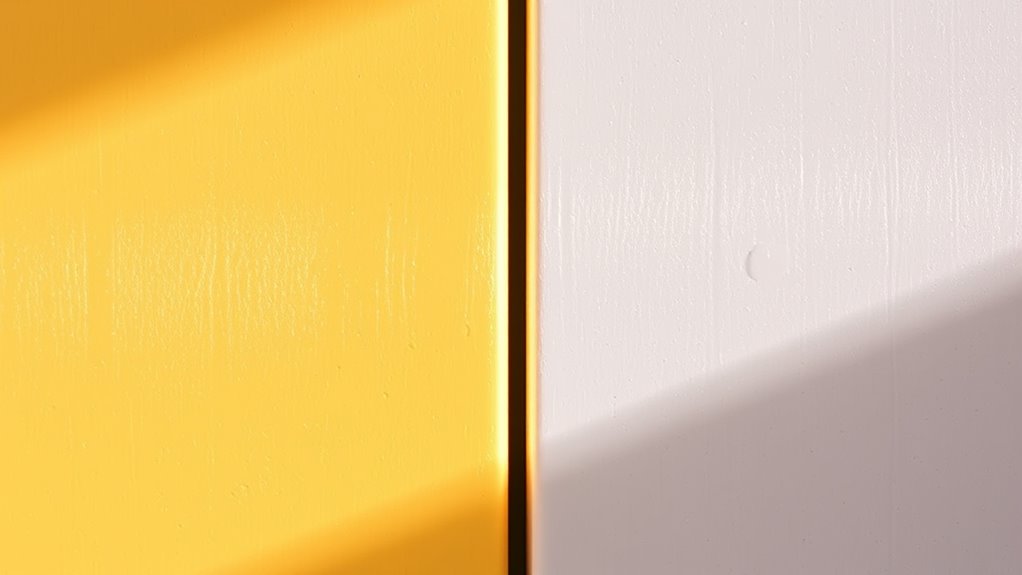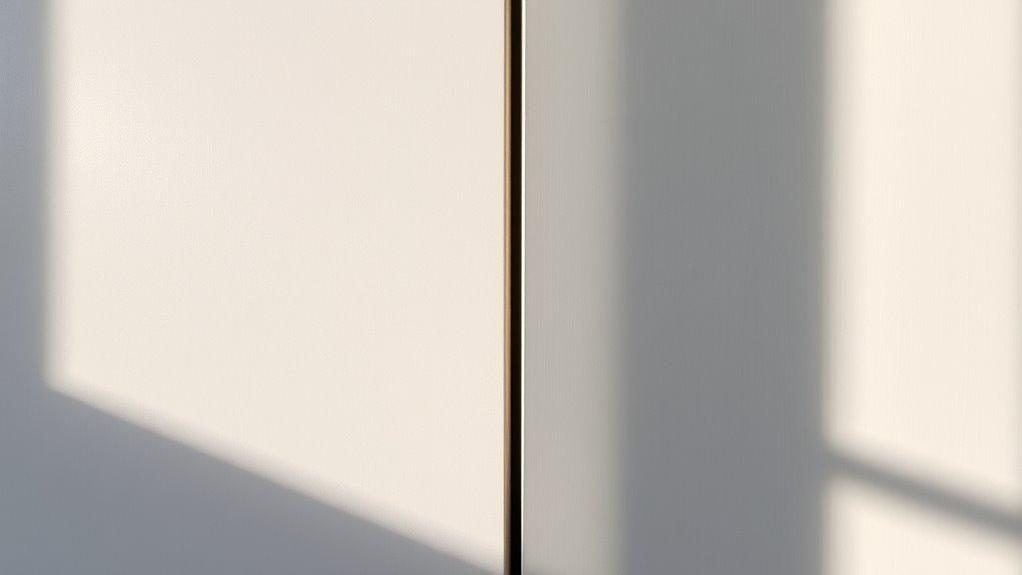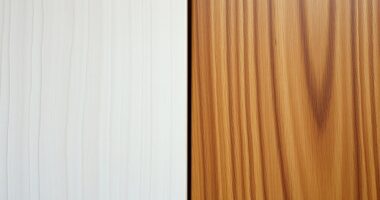For high-use areas, semi-gloss is the better choice because it’s more durable, easier to clean, and resists scratches and stains better than satin. It’s ideal for spaces like kitchens, bathrooms, and kids’ rooms where frequent cleaning and bumps happen. Satin finishes look nice but show wear more quickly and are harder to maintain over time. To learn more about which sheen works best for your needs, keep exploring the details.
Key Takeaways
- Semi-gloss finishes are more durable and resistant to scratches, stains, and moisture, making them ideal for high-use areas.
- They are easier to clean with a damp cloth, maintaining their appearance longer in busy spaces.
- Satin finishes are softer and may show wear more quickly, requiring more delicate cleaning and maintenance.
- Semi-gloss’s hardness and durability make it better suited for kitchens, bathrooms, and trim that experience frequent use.
- For long-term performance and low upkeep, semi-gloss is generally the preferred choice for high-traffic, high-use pieces.

When choosing paint finishes for your home, understanding the differences between semi-gloss and satin can make a significant impact on your project’s look and durability. One of the key aspects to consider is durability differences. Semi-gloss finishes tend to be more durable than satin. They resist scratches, stains, and moisture better, making them an excellent choice for high-traffic areas, kitchens, bathrooms, or trim work. The harder surface of semi-gloss paint holds up well over time, even with frequent cleaning. Satin finishes, while still durable, are slightly softer. They can withstand regular use but may show wear more quickly, especially in areas prone to bumps and scrapes. If you’re looking for a finish that maintains its appearance longer in demanding spaces, semi-gloss is generally the better option. Additionally, paint finish durability plays a crucial role in long-term satisfaction with your paint choice.
Cleaning and maintenance are also vital considerations. Semi-gloss paints are easier to wipe down and clean because their smooth, shiny surface repels dirt and grime more effectively. You can usually clean semi-gloss walls with a damp cloth or a gentle cleaner without worrying about damaging the finish. This makes semi-gloss ideal for spaces that need frequent cleaning, such as kitchens, bathrooms, or children’s rooms. Satin finishes, with their slightly softer sheen, can be more prone to showing fingerprints, smudges, or water spots. While still relatively easy to clean, they might require more delicate handling and less abrasive cleaning products. This difference in cleaning and maintenance can influence your choice, especially if you prioritize low upkeep in high-use areas.
Frequently Asked Questions
How Do Semi-Gloss and Satin Finishes Affect Interior Lighting?
Semi-gloss finishes reflect more light due to their higher gloss level, making your space feel brighter and more vibrant. Satin finishes, with a softer sheen, reflect less light, creating a more subdued and elegant look. When choosing between them, consider how much light reflection you want; semi-gloss amplifies brightness, while satin offers a gentle glow, enhancing the ambiance of high-use pieces without overwhelming the room.
Are There Environmental Considerations Between Semi-Gloss and Satin Paints?
Like the choices in a Greek myth, your options matter. When comparing semi-gloss and satin paints, eco-friendly options and VOC emissions are key. Satin finishes often emit fewer VOCs, making them more environmentally friendly, especially if you seek low-VOC or zero-VOC paints. Semi-gloss may contain higher VOC levels, but many brands now offer greener formulas. Always check labels for eco-friendly options to reduce your environmental impact while maintaining beautiful, high-use surfaces.
Can Semi-Gloss or Satin Finishes Be Used Outdoors Effectively?
Yes, both semi-gloss and satin finishes can be used outdoors effectively. You should choose a paint with strong outdoor durability and UV resistance to withstand weather conditions. Semi-gloss offers excellent durability and easy cleaning, making it ideal for high-traffic areas. Satin provides a softer appearance with decent durability, suitable for less exposed surfaces. guarantee you select a quality exterior paint for long-lasting, vibrant results.
How Do Cleaning Requirements Differ for Semi-Gloss Versus Satin?
You’ll find that semi-gloss finishes are easier to clean because they resist moisture and stains better, making surface maintenance simpler. Satin finishes, while still durable, require gentler cleaning to avoid dulling the sheen. For high-use pieces, semi-gloss offers better surface durability with less effort, whereas satin might need more careful cleaning to maintain its appearance. Choose semi-gloss for easier upkeep and long-lasting surface resilience.
What Are the Cost Differences Between Semi-Gloss and Satin Paints?
You’ll find that semi-gloss paints tend to be slightly more expensive than satin paints, mainly because of their durability and reflective qualities. The cost comparison shows that paint pricing for semi-gloss can be 10-20% higher, especially for premium brands. However, keep in mind that investing in semi-gloss might save you money long-term due to its easier cleaning and longer-lasting finish, which can reduce repainting frequency.
Conclusion
Ultimately, choosing between semi-gloss and satin comes down to your specific needs and preferences. If you want durability and a subtle shine, semi-gloss might be your best bet. For a softer, more forgiving finish, satin is ideal. Remember, “A little caution goes a long way,” so consider your high-use pieces carefully. Whichever you pick, you’ll be making a smart choice for your space’s style and longevity.









